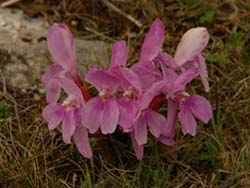Studies on some Himalayan ginger flowers have contributed novel empirical evidence to Darwin's self-pollination theory, according to CAS researchers from the Xishuangbanna Tropical Botanical Garden.
Pollination is the act of transferring pollen grains from the anther (male organ) of a flower to the stigma (female organ), which is a necessary step in the sexual reproduction of flowering plants. It can occur between anthers and stigmas within flowers or between different flowers on the same plant (self-pollination), or between flowers on different plants (cross-pollination). If the pollination is successful, the result is a fertilized ovule that may grow into a seed. Successful reproduction is a major selective force influencing floral trait.
Offspring resulting from self- fertilization usually exhibit reduced viability and fertility compared with those arising from cross-fertilization. Thus, it is not unexpected that many floral adaptations have evolved to reduce inbreeding depression and other costs incur by self-pollination. However, about one fifth of the Earth's flowering plants still choose to be fertilized with their own pollen. To explain this phenomenon, Darwin proposed a "reproductive assurance hypothesis" in the 1870s, which says the plants self-pollinate for the sake of seed production when pollinators or mating chances are scarce. The theory later became a widely-accepted explanation for the evolution of self-fertilization in plants, but it has received little empirical support ever since.
Prof. LI Qingjun and his PhD student ZHANG Zhiqiang with the CAS Xishuangbanna Tropical Botanical Garden have been actively involved in the studies of Roscoea, a high-latitude genus of the predominantly tropical Ginger family. The orchid-resembling Roscoea flowers have differentiated from the ginger family and adapted itself to alpine habitats since the upheaval of the Qinghai-Tibet Plateau.
Zhang and Li's recent focus is on Roscoea schneideriana, a small Himalayan perennial herb typically found in mixed forests, stony pastures and rocky mountain cliffs across Yunnan, Sichuan and Tibet at around 3,000m above the sea level. With falcate leaf blade, purple/white flowers, yellow anther and hooked stigma, the plants are special in two ways. First, despite the bright color of their petals, few insects are attracted to pollinate them. Second, given the fact that they are not fertilized with the help of pollinators, their fruit set is exceptionally high compared to other natural populations of flowering plants.
Will they serve new evidence to Darwin's hypothesis?
To decode the pollination mechanism of R. schneideriana, Zhang and Li first carried out pollinator exclusion experiments to estimate its capacity of autonomous selfing. They discovered that the selfing is achieved by hooked stigmas curling towards the anther and contacting pollen grains, and those flowers with potential pollinators excluded set as many seeds per fruit as hand-selfed and opened flowers. Then the anther was removed at different times during flowering to reveal the timing of selfing. It turned out that the selfing mostly occurs at an early stage of anthesis, that is, within two days of blossom.
Zhang and Li also emasculated some flowers to compare their reproduction ability with that of the self-pollinated ones. Results showed during the flowering seasons of 2005-2007, autonomous selfing increased seed production by an average of 84 percent in four populations of R. schneideriana.
Last but not least, the botanists made a comparison between progeny of self- and cross-pollinated R. schneideriana, quantifying the cumulative inbreeding depression of the plant as 0.226.
The study suggests that under poor pollination conditions, autonomous selfing has been selected by the alpine ginger because it can provide substantial reproductive assurance with very low costs. It is convincing evidence to Darwin's theory based upon a long-term investigation across several flowering seasons within a natural population.
According to Zhang and Li, violet and yellow are both bright colors to attract bees for pollination. The lack of pollinators in the area might be due to climate factors: the flowering seasons of R. schneideriana just fall across the major raining seasons of the region. The collapse of plant-pollinator mutualism may also cause R. schneideriana to become dependent on autonomous selfing to achieve successful pollination.

The study will be published in the October issue of Annals of Botany in 2008.
|

